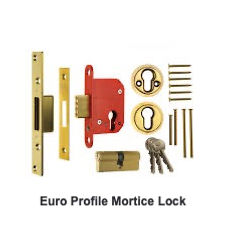ALL LOCK PROBLEMS SOLVED FAST – UPVC DOORS & WINDOWS REPAIRED
BIFOLD DOOR REPAIRS – ALL LOCKSMITH SERVICES






Types of Mortice Locks We Can Supply and Fit in Haywards Heath: A 360‑Degree Snapshot
Mortice locks—spelled “mortice” on this side of the Atlantic—sit inside a chisel‑cut pocket in the door edge, giving a neater appearance and far greater resistance to force than surface‑mounted rim locks. British insurers, building regulations, and even the humble DIYer group these locks into a handful of recognisable categories. Below is a concise, ±500‑word survey of the main mortice‑lock types you’ll meet in UK homes and small‑business premises, along with the standards that govern their use.
1. Five‑Lever Mortice Deadlock
Purpose: High‑security night lock for entry doors.
Operation: Key from both sides throws a solid rectangular bolt. No handle or latch.
Why it matters: The “five levers” inside the mechanism create thousands of key‑code combinations and resist simple picking. To satisfy most household‑insurance policies, look for the British Standard kite‑mark logo and the legend BS 3621 stamped on the faceplate. Modern BS 3621 deadlocks must also withstand drill, saw, and torque attacks and include a hardened anti‑saw bolt with two inset rollers.
2. Five‑Lever Mortice Sashlock
Purpose: Combines convenience of a handle‑latch with the security of a deadbolt.
Operation: Close the door and the spring latch engages automatically; turn the key to project the deadbolt for full lock‑up.
Use cases: Front doors that are in constant daily use, or internal doors that need occasional locking (e.g., home office). If fitted on an external door, insurers again insist on the BS 3621 version. Many timber‑fronted Victorian terraces across the UK use the sashlock + nightlatch pairing—daytime convenience from the rim nightlatch, night‑time insurance cover from the mortice sashlock.
3. Three‑Lever Mortice Locks
Purpose: Budget security for internal doors, cupboards, and flats’ bedrooms.
Specs: Fewer levers mean fewer key differs and reduced pick‑resistance, so these are generally not suitable for final‑exit doors. Suppliers market them as “economy” or “contract” locks for situations where you want a key but don’t need insurance‑grade strength.
4. Escape (Bathroom/Privacy) Mortice Locks
Function profile: Thumb‑turn or push button on the inside provides privacy; emergency‑release slot or coin turn on the outside lets someone gain entry quickly if a child or vulnerable person gets stuck. The bolt is usually a softer brass or zinc alloy rather than hardened steel because its job is privacy, not burglary defence. Some models combine the privacy turn with a sprung latch so the door can remain closed but unlocked.
5. Euro‑Profile Mortice Locks
Instead of an integrated lever mechanism, these locks accept a removable euro cylinder—the same shape used in uPVC multipoint doors. Benefits include quick “re‑keying” by swapping cylinders and the possibility of master‑key suites. When used on wooden or composite doors, the case itself provides the latch and deadbolt, while the cylinder supplies the key control. Choose a cylinder rated TS 007 3‑Star or pair a 1‑Star cylinder with a 2‑Star security escutcheon to defeat snapping and bumping attacks.
6. Bathroom Deadbolt & Turn Sets
A pared‑down mortice lock containing only a sliding bolt operated by an internal thumb‑turn and an external coin‑slot. The bolt’s throw is usually 20 mm—plenty for privacy but shorter than the 20–25 mm hardened throws demanded of BS‑rated locks. Increasingly, these are sold as part of designer lever‑handle sets for modern refurbs.
7. Electrically Released Mortice Locks
Often seen on shared front doors or office receptions, these locks keep the mechanical strength of a standard dead‑ or sashlock but add a small solenoid that retracts the latch when buzzed from an entry phone or access‑control reader. Fail‑secure versions remain locked during a power cut; fail‑safe versions unlock for fire‑exit routes.
Making the Right Choice
For a final‑exit timber door in the UK, police‑backed Secured by Design and most insurers insist on either a BS 3621 five‑lever deadlock/sashlock or a PAS 24‑certified doorset. Internal doors can drop to three‑lever or privacy variants. Always pair a mortice lock with long (75 mm+) security screws in the strike plate and, if the frame is old softwood, consider reinforcing plates. A quality mortice lock, properly installed, remains one of the most cost‑effective, burglary‑resistant upgrades you can make to your property in Haywards Heath.


